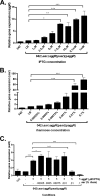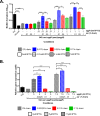Dual Function of Aar, a Member of the New AraC Negative Regulator Family, in Escherichia coli Gene Expression
- PMID: 32253248
- PMCID: PMC7240098
- DOI: 10.1128/IAI.00100-20
Dual Function of Aar, a Member of the New AraC Negative Regulator Family, in Escherichia coli Gene Expression
Abstract
Enteroaggregative Escherichia coli (EAEC) is an E. coli pathotype associated with diarrhea and growth faltering. EAEC virulence gene expression is controlled by the autoactivated AraC family transcriptional regulator, AggR. AggR activates transcription of a large number of virulence genes, including Aar, which in turn acts as a negative regulator of AggR itself. Aar has also been shown to affect expression of E. coli housekeeping genes, including H-NS, a global regulator that acts at multiple promoters and silences AT-rich genes (such as those in the AggR regulon). Although Aar has been shown to bind both AggR and H-NS in vitro, functional significance of these interactions has not been shown in vivo In order to dissect this regulatory network, we removed the complex interdependence of aggR and aar by placing the genes under the control of titratable promoters. We measured phenotypic and genotypic changes on downstream genes in EAEC strain 042 and E. coli K-12 strain DH5α, which lacks the AggR regulon. In EAEC, we found that low expression of aar increases aafA fimbrial gene expression via H-NS; however, when aar is more highly expressed, it acts as a negative regulator via AggR. In DH5α, aar affected expression of E. coli genes in some cases via H-NS and in some cases independent of H-NS. Our data support the model that Aar interacts in concert with AggR, H-NS, and possibly other regulators and that these interactions are likely to be functionally significant in vivo.
Keywords: ANR; Aar; AggR; enteroaggregative E. coli.
Copyright © 2020 American Society for Microbiology.
Figures







Similar articles
-
A Mini-Review of Enteroaggregative Escherichia coli with a Specific Target on the Virulence Factors Controlled by the AggR Master Regulator.Pol J Microbiol. 2023 Dec 16;72(4):347-354. doi: 10.33073/pjm-2023-037. eCollection 2023 Dec 1. Pol J Microbiol. 2023. PMID: 37875068 Free PMC article. Review.
-
A large family of anti-activators accompanying XylS/AraC family regulatory proteins.Mol Microbiol. 2016 Jul;101(2):314-32. doi: 10.1111/mmi.13392. Epub 2016 May 6. Mol Microbiol. 2016. PMID: 27038276 Free PMC article.
-
The AraC Negative Regulator family modulates the activity of histone-like proteins in pathogenic bacteria.PLoS Pathog. 2017 Aug 14;13(8):e1006545. doi: 10.1371/journal.ppat.1006545. eCollection 2017 Aug. PLoS Pathog. 2017. PMID: 28806780 Free PMC article.
-
Autoactivation of the AggR regulator of enteroaggregative Escherichia coli in vitro and in vivo.FEMS Immunol Med Microbiol. 2010 Apr;58(3):344-55. doi: 10.1111/j.1574-695X.2010.00645.x. Epub 2010 Jan 28. FEMS Immunol Med Microbiol. 2010. PMID: 20132305
-
Pathogenesis of enteroaggregative Escherichia coli infection.FEMS Microbiol Lett. 2006 Jan;254(1):12-8. doi: 10.1111/j.1574-6968.2005.00005.x. FEMS Microbiol Lett. 2006. PMID: 16451173 Review.
Cited by
-
Antimicrobial resistance and gene regulation in Enteroaggregative Escherichia coli from Egyptian children with diarrhoea: Similarities and differences.Virulence. 2021 Dec;12(1):57-74. doi: 10.1080/21505594.2020.1859852. Virulence. 2021. PMID: 33372849 Free PMC article.
-
Highly-conserved regulatory activity of the ANR family in the virulence of diarrheagenic bacteria through interaction with master and global regulators.Sci Rep. 2023 Apr 29;13(1):7024. doi: 10.1038/s41598-023-33997-0. Sci Rep. 2023. PMID: 37120613 Free PMC article.
-
A Mini-Review of Enteroaggregative Escherichia coli with a Specific Target on the Virulence Factors Controlled by the AggR Master Regulator.Pol J Microbiol. 2023 Dec 16;72(4):347-354. doi: 10.33073/pjm-2023-037. eCollection 2023 Dec 1. Pol J Microbiol. 2023. PMID: 37875068 Free PMC article. Review.
-
Site specific incidence rate of virulence related genes of enteroaggregative Escherichia coli and association with enteric inflammation and growth in children.Sci Rep. 2021 Nov 30;11(1):23178. doi: 10.1038/s41598-021-02626-z. Sci Rep. 2021. PMID: 34848801 Free PMC article.
-
Involvement of promoter/enhancers in a feedback loop to regulate human gene expression.Heliyon. 2020 Sep 15;6(9):e04934. doi: 10.1016/j.heliyon.2020.e04934. eCollection 2020 Sep. Heliyon. 2020. PMID: 32995621 Free PMC article.
References
-
- Mohamed JA, Huang DB, Jiang Z-D, DuPont HL, Nataro JP, Belkind-Gerson J, Okhuysen PC. 2007. Association of putative enteroaggregative Escherichia coli virulence genes and biofilm production in isolates from travelers to developing countries. J Clin Microbiol 45:121–126. doi:10.1128/JCM.01128-06. - DOI - PMC - PubMed
Publication types
MeSH terms
Substances
Grants and funding
LinkOut - more resources
Full Text Sources
Medical
Miscellaneous

